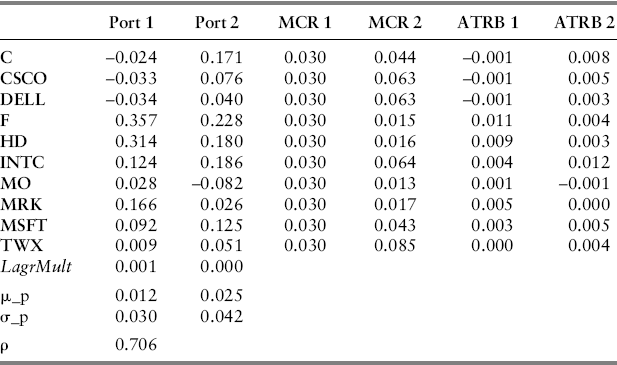Performance Attribution
I label this Port 1 (it is portfolio 1 in Chapter 6) and compute its monthly expected return (1.2 percent) and risk (3 percent). Their annualized counterparts, if you are interested, are 14.4 percent return and 10.4 percent risk. Notice that the portfolio is heavily weighted to Ford, Home Depot, and Intel (diversification opportunities) with a sizable allocation to Merck but short positions (negative weights) in the riskiest of assets (C, CSCO, and DELL) and a tiny position in TWX. You can see that even though these short positions were for assets with the highest returns, they were also very risky and had little diversification opportunity to exploit. On the other hand, although Ford does not have a particularly high return, its returns are negatively correlated with several other firms.
Portfolio 1 is the left-most point on the efficient frontier. Let's solve for another portfolio, one with a targeted return. Since there are an infinite number of them, the choice of return is somewhat arbitrary but still should be chosen with some care since it is important the current asset mix be able to deliver that return. Portfolio 1 earns a 1.2 percent return. We therefore target a portfolio 2 return that is higher (and therefore riskier) at, say, 3 percent monthly. Because portfolio 2 involves an additional constraint (mean return equal to 3 percent), I have highlighted the extension to the original matrix A and the vector b from the solution involving the first order conditions (again, see Chapter 6 for a review). The solution labeled Port 2 reflects these changes and is displayed in Table 7.1 for convenience:
Table 7.1 Two Mean-Variance Efficient Portfolios.

Port 2 is indeed riskier at 5.1 percent (monthly). This makes sense; there is a positive risk-return trade-off. The correlation between the two portfolios is 58.8 percent. Port 2 has a rather large short position in MO counterbalanced by larger exposures to C, INTC, MSFT, F, and HD. It appears to be more diversified in that regard and there are many stocks in this 10-stock universe that will help achieve that targeted return. Port 1, on the other hand, had the objective of minimizing risk and not achieving any stated return. Thus, Port 1 finds the least risky mix regardless of return.
It is interesting that the marginal contribution to risk (MCR) for Port 1 is the same across all assets. This may seem like a mistake at first, but it is not. Upon reflection, Port 1 is special; it is the minimum variance portfolio. The chapter on risk budgeting discusses this point in more detail, but this is the intuition. The MCR is a derivative, which in this case represents a gradient on the loss surface (a tangency to the risk surface). Since it is the minimum risk portfolio, it must be at a minimum point on the loss surface, and here the gradient has zero slope. Therefore, altering the weight by some fixed amount Δw to any asset will have the same impact on portfolio risk in any direction. The MCR for Port 2, on the other hand, differs across the portfolio; it is a minimum risk portfolio for the stated return, but not the minimum risk portfolio. Here, TWX has the highest marginal impact on risk, but it is also the riskiest of all the firms. Altering the weight vector in the direction of TWX will therefore increase risk the most.
Suppose instead that we are interested in decomposing risk across the portfolio. Attribution risk tells us the proportion of portfolio risk accounted for by each position in the portfolio. Since the sum of the attributions must equal the portfolio's risk, then we get a decomposition of risk. For example, the sum of ATRB 2 from before is equal to 5.1 percent. Therefore, INTC, at 1.4 percent, is the highest contributor to portfolio risk (about 27.4 percent of total risk is in this asset) and about 21.5 percent of total risk is in C. Together, these two positions account for almost half the portfolio risk despite the fact that risk is spread fairly evenly across the portfolio on the margin.
